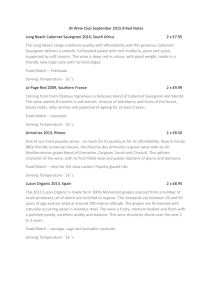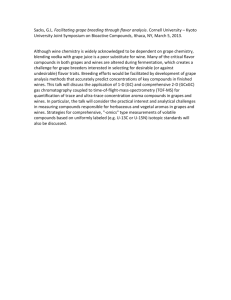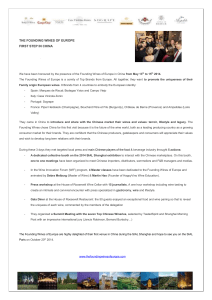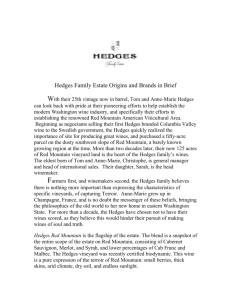Green characters in Cabernet wines
advertisement
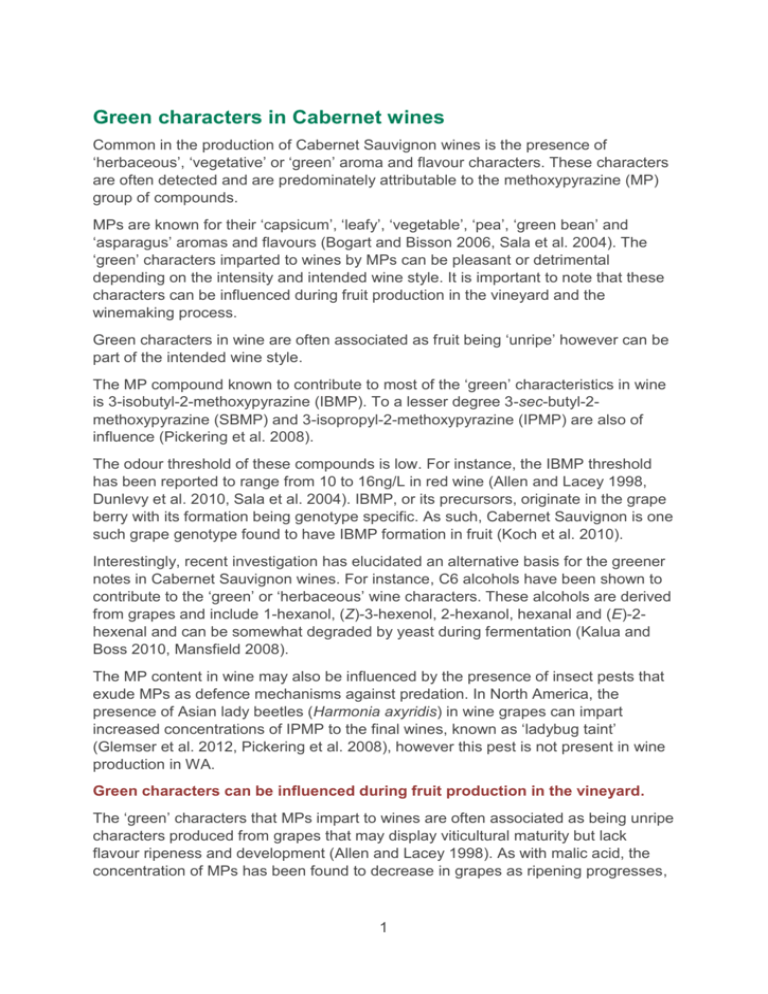
Green characters in Cabernet wines Common in the production of Cabernet Sauvignon wines is the presence of ‘herbaceous’, ‘vegetative’ or ‘green’ aroma and flavour characters. These characters are often detected and are predominately attributable to the methoxypyrazine (MP) group of compounds. MPs are known for their ‘capsicum’, ‘leafy’, ‘vegetable’, ‘pea’, ‘green bean’ and ‘asparagus’ aromas and flavours (Bogart and Bisson 2006, Sala et al. 2004). The ‘green’ characters imparted to wines by MPs can be pleasant or detrimental depending on the intensity and intended wine style. It is important to note that these characters can be influenced during fruit production in the vineyard and the winemaking process. Green characters in wine are often associated as fruit being ‘unripe’ however can be part of the intended wine style. The MP compound known to contribute to most of the ‘green’ characteristics in wine is 3-isobutyl-2-methoxypyrazine (IBMP). To a lesser degree 3-sec-butyl-2methoxypyrazine (SBMP) and 3-isopropyl-2-methoxypyrazine (IPMP) are also of influence (Pickering et al. 2008). The odour threshold of these compounds is low. For instance, the IBMP threshold has been reported to range from 10 to 16ng/L in red wine (Allen and Lacey 1998, Dunlevy et al. 2010, Sala et al. 2004). IBMP, or its precursors, originate in the grape berry with its formation being genotype specific. As such, Cabernet Sauvignon is one such grape genotype found to have IBMP formation in fruit (Koch et al. 2010). Interestingly, recent investigation has elucidated an alternative basis for the greener notes in Cabernet Sauvignon wines. For instance, C6 alcohols have been shown to contribute to the ‘green’ or ‘herbaceous’ wine characters. These alcohols are derived from grapes and include 1-hexanol, (Z)-3-hexenol, 2-hexanol, hexanal and (E)-2hexenal and can be somewhat degraded by yeast during fermentation (Kalua and Boss 2010, Mansfield 2008). The MP content in wine may also be influenced by the presence of insect pests that exude MPs as defence mechanisms against predation. In North America, the presence of Asian lady beetles (Harmonia axyridis) in wine grapes can impart increased concentrations of IPMP to the final wines, known as ‘ladybug taint’ (Glemser et al. 2012, Pickering et al. 2008), however this pest is not present in wine production in WA. Green characters can be influenced during fruit production in the vineyard. The ‘green’ characters that MPs impart to wines are often associated as being unripe characters produced from grapes that may display viticultural maturity but lack flavour ripeness and development (Allen and Lacey 1998). As with malic acid, the concentration of MPs has been found to decrease in grapes as ripening progresses, 1 therefore a high concentration of MPs in grapes at harvest has the association with this lack of ripeness (Roujou de Boubeé et al. 2000). The high content of MPs in grapes at harvest may be a signal to deter consumption by predators due to a lack of ripeness and seed viability (Bogart and Bisson 2006, Koch et al. 2012). During grape berry ripening, the proportion of MPs increases in skins, and decreases in bunch stems and berry seeds (Roujou de Boubeé et al. 2002). The IBMP concentration in grapes is heightened prior to the onset of ripening then decreases until harvest (Koch et al. 2012). Winemaking studies in France, found the MP content of Cabernet Sauvignon wines to be principally dependent on the MP content of the grapes (Roujou de Boubeé et al. 2002). MPs were predominately extracted in grape musts, regardless of the fermentation duration and the number of times the cap was pumped over with wine (Roujou de Boubeé et al. 2002). It is therefore important to concentrate on techniques to minimisation the MP content during the growth and production of grapes. Vineyard operations imposed prior to veraison are highly effective in reducing green characters in wine. MP production in the vineyard In the vineyard, a number of applications have been investigated to minimise the production of ‘green’ characteristics in grapes and wine. What is interesting is the high effectiveness that these treatments have shown when imposed prior to veraison. An important contributor to the MP content of grapes is the light intensity that grape bunches receive during growth. In particular, the light intensity from fruit set to veraison is most influential on the production of IBMP (Koch et al. 2012). That is, light has been shown to be related to the degradation of IBMP in field-grown grapevines. Light exposure to grape bunches prior to veraison can reduce green characters in wine. In Cabernet Sauvignon studies in WA, the effect of shade during grape growth and ripening on the production of herbaceous characters in wine was investigated in Margaret River. Various canopy treatments were imposed where grapevines were shaded (with shade cloth) or exposed to light from flowering to veraison then from veraison to harvest. Results showed that wines produced from fruit of vines that were (a) shaded from flowering to harvest; or (b) shaded from flowering to veraison then light exposed from veraison to harvest; were higher in IBMP than those that were light exposed (Robinson et al. 2011b). This is supported by studies in the US that also showed that the light intensity that a canopy was exposed to prior to veraison was influential on the IBMP concentration in Cabernet Sauvignon grapes (Koch et al. 2012). The preveraison stage of berry growth is found to be a key stage for the biosynthesis of volatile compounds and their precursors (Kalua and Boss 2009). 2 Low vigour vines have low levels of IBMP in fruit while high vigour vines have high levels. Cabernet Sauvignon studies in Margaret River also found grapevine vigour and bunch thinning level of vines to influence the concentration of IBMP in wines. Low vigour vines and vines of low vigour that were bunch thinned were found to have lower concentrations of IBMP in wine than high vigour vines (Wilkinson et al. 2006). Interesting, the high vigour bunch-thinned vines had the highest concentrations of IBMP in wine. This may be due to the positioning of bunches within the canopy and the light intensity, or lack of light intensity, that bunches grown within high vigour vines may receive. Warm temperatures during the growing season reduce green characters in grapes. In conjunction with light intensity is the effect of temperature. This is also influential in the production of MPs in grapes. In controlled growth chamber experiments, Koch et al. (2012) discovered that warm temperatures during the growing season (29 to 32oC) reduced the IBMP concentration of grapes to a similar degree as light exposure in the field. Other yield regulation methods employed early in fruit development have shown influence on the aromas and flavours of Cabernet Sauvignon wines. In many studies, the regulation of fruit yield has been via the physical removal of grape inflorescence or bunches during the periods of flowering, fruit set, veraison or post-veraison. As such, the bunch thinning effects were not as pronounced or as influential as the pruning regulation conducted early in fruit development (Chapman et al. 2004a). Vines pruned to high bud numbers with high yields produce low green characters in wine. The influence of pruning level on crop load has shown to impact the green characters of Cabernet Sauvignon wines. Vines pruned during dormancy to low bud numbers to produce low yields produced wines high in ‘veggie’ aromas and flavours, ‘bell pepper’ aroma, ‘bitterness’ and ‘astringency’ (Chapman et al. 2004a). This was in contrast to vines pruned to retain high bud numbers producing high yields that subsequently produced fruit for wines higher in ‘blackberry’ and ‘jam’ aromas and ‘fruity’ flavour (Chapman et al. 2004a). Generally the ‘fruity’ characters of the wines were seen to increase and the ‘veggie’ wine characters decreased as the bud numbers and yield increased (Chapman et al. 2004a). Other authors have shown the relationship between IBMP and fruit yield to be inversely related. That is, as yield increases the concentration of IBMP decreases (Chapman et al. 2004b). Other canopy management practices have been found to impact on the concentration of IBMP in Cabernet Sauvignon fruit and wine that can be related to the exposure of fruit to light. One such practice is leaf removal within the canopy fruiting zone or to leaves alone. Leaf removal early in the season has been found to make the biggest impact on the reduction of IBMP concentrations in fruit. For instance, leaves removed from Cabernet Franc and Merlot vines 10 and 40 days after flowering reduced the IBMP concentration in fruit at harvest (Scheiner et al 3 2010). This reduction of IBMP concentration was more pronounced than leaf removal treatments later in development. Leaf removal studies with Cabernet Sauvignon vines discovered that the removal of leaves between fruit set and bunch closure had a greater impact on the concentration of IBMP in grapes than if the leaves were removed later in the season (that is, from veraison onwards) (Roujou de Boubeé 2003). Although, in Western Australian vineyards, the protection of fruit from extreme temperatures, or ‘heat spikes’, needs to be considered when leaf removal practices are employed. Weather conditions can influence MP development. The environmental influences on MPs should not be ignored. Specific weather events during the ripening of grapes have been noted for increasing the MPs in fruit especially if during the veraison period. Roujou de Boubeé (2003) noted that a large increase in rainfall during mid-veraison resulted in enhanced soil water reserves with the grapevines beginning to actively grow. This in turn resulted in the increase in IBMP content of grapes. It was therefore concluded that the grapevine water status can be of influence to IBMP production in the grape prior to veraison (Roujou de Boubeé 2003). Recent research on IBMP on Merlot fruit and wine in California investigated the contribution of increased irrigation and nitrogen fertilisation (Mendez-Costabel et al. 2014). The additional irrigation and fertiliser resulted in decreased fruit exposure, increased canopy growth and IBMP concentration in fruit. Therefore the control of canopy growth and vine water status early in the season was thought to indirectly reduce IBMP in grapes and ‘green’ aromas in wine (Mendez-Costabel et al. 2014). The management of canopy and vine water status early in the season was also found to be beneficial in the management of MPs in fruit. MPs and winemaking The relationship between the aromas and flavours that MPs can impart on Cabernet Sauvignon wines is complex. The fruit-related ‘berry’ and ‘ripe’ characters of Cabernet Sauvignon wines may be juxtaposed with those of the ‘herbaceous’, ‘green’ and ‘green capsicum’ related characters that the MPs may impart (Preston et al. 2008, Robinson et al. 2011a). As such, wines that are high in MPs can be low in fruit characters and vice versa. It is often difficult to determine the relative intensity of MP characters sensorally. Studies have demonstrated sensory scores to not correlate with the chemical analysis for MPs for Cabernet Sauvignon (Preston et al. 2008). As such, the relative intensity of MP imparted characters may be difficult to determine, however the detection threshold for the compounds results in the characters still able to be detected at low levels. IBMP is readily extracted in musts after 24 hours. The influence of winemaking processes and techniques on the development and intensity of MPs in wine has been evaluated in numerous studies. However, some research is conflictual and demonstrates that outcomes may differ depending on 4 variety. IBMP is found to be readily extracted from grape bunches during the initial stages of grape processing. During the processing of Sauvignon Blanc grapes, the highest concentrations of IBMP were found in juice samples taken when filling the press and at the beginning of the press cycle (Roujou de Boubeé 2003). For Cabernet Sauvignon the concentration of IBMP in musts after 24 hours, prior to alcoholic fermentation, was similar to that of final wines. Small lot winemaking experiments showed the rapid extraction of IBMP from grapes into the must within the first 24 hours and prior to the commencement of fermentation (Roujou de Boubeé 2003). Researchers found the IBMP content of final wines were not influenced by plunging of musts, skin contact time and pumping over skins (Roujou de Boubeé 2003). However, the IBMP content of Cabernet Sauvignon, Merlot and Cabernet Franc wines after pressing can be greater than that of free run wine (Kotseridis et al 1999, Roujou de Boubeé 2002). When looking at the influence of wine production process on the concentrations of MPs in wines it is important to note their origin within the grapevine. In particular, Cabernet Sauvignon bunches are known to contain MPs in the largest concentration in bunch stems and to a lesser degree in skins and seeds with low concentrations detected in grape pulp (Hashizume and Umeda 1996, Roujou de Boubeé 2002). It is thought that the effective removal of bunch stems early in the winemaking process could reduce the concentration of MPs in the final wines (Roujou de Boubeé 2002, Sala et al. 2004). Finished wines are higher in MPs than grape juice. Finished wines can be two to threefold higher in MP concentration than the grape juice prior to fermentation (Sala et al. 2004). It is suggested that the extraction of MPs from grape skins may be enhanced during pressing due to skin damage and the presence of ethanol (Kotseridis et al. 1999). However, this may be dependent on the variety and influence on the stalk contact during fermentation. Merlot musts sampled eight days from the beginning of maceration contained heightened concentrations of IBMP in comparison to samples taken at three and five days (Kotseridis et al. 1999). The influence of yeast selection has been shown to have a variable effect on the concentration of MPs in the final wine. In particular, studies have investigated the effect on yeast selection to reduce IPMP from the presence of ladybug taint. Pickering et al. (2008) discovered IPMP concentration not to be affected by EC1118, Lalvin D21 and Lalvin D80 yeast strain although it was found to increase by 29% (11ng/L) in wine fermented by Lalvin BM45. However, sensory analysis of the wines made with different yeast strains showed Lalvin D80 to have a higher intensity of ‘green pepper’ and ‘green vegetable’ aromas that was in contrast to Lalvin D21 that produced wines low in green characters with high intensity of ‘jammy’ and ‘red berry’ flavours (Pickering et al. 2008). Malolactic fermentation has not been found to have an effect on the MP levels in wine (Sidhu et al. 2013). A number of winemaking techniques have been shown to reduce the concentration of MPs in wine. 5 MPs have been found to decrease in wine when juice is settled or clarified prior to fermentation (Kotseridis et al. 2008, Roujou de Boubeé et al. 2002). Also, the heating of grape musts to between 60 and 80°oC for a short period of time (thermovinification) has been found to decrease the ‘vegetal’ characteristics in some wines and could be a useful application where grapes have not achieved optimal ripeness (Roujou de Boubeé 2003). As such, IBMP is found to be volatilised during heating and has a boiling point of 50oC (Roujou de Boubeé 2003). Previous studies have shown packaging and storage methods to affect the MP concentrations in wine over time. The degradation of MPs is known to be accelerated when wine is exposed to light – such as when wine is stored in clear bottles in comparison to dark or coloured bottles (Blake et al. 2010, Sidhu et al. 2013). This degradation may be a function of light intensity, temperature and time. For example, the effect of light environment (fluorescent lighting or dark environment) and temperature (ambient 22oC or cellar temperature 12oC) on the degradation of MPs in wines stored in clear, green and amber bottles showed levels to decrease by 30% on average across all treatments with any one treatment not being more effective than the other at MP removal or reduction (Blake et al. 2010). The MP concentration in wine is found to decrease depending on the packaging type. For instance, after 18 months in storage the IBMP concentration was found to decrease in wine by 45% when stored in tetrapak (Blake et al. 2009). The packaging effect on MPs also extended to closure types with a greater decrease in MPs found to be in wines stored with synthetic cork closures in comparison to natural corks and screw caps (Blake et al. 2009). Other studies have investigated the possibility of MP reduction in wine through a variety of novel means. Food grade silicone tubing was discovered to absorb MP when added to grape juice prior to the fermentation of musts (Ryona et al. 2012). Both natural and synthetic corks have been found to have a ‘binding affinity’ with MPs in wine and were used to remediate wines (Pickering et al. 2010) Several proteins have been investigated on their effectiveness in MP removal in grape musts. A patent was awarded in 2010 to one protein that has been found to effectively reduce 60% of the MPs in wine (Inglis et al. 2010). However, some authors may caution applying these techniques as they may alter wine chemistry to produce inferior or sub-standard wines (Sidhu et al. 2013). MP and further opportunities Demonstrate and evaluate the use of vineyard based techniques on the reduction of methoxypyrazines in grapes and wine Investigate winemaking techniques that influence the production of green characters in wine Investigate how to obtain lower levels of methoxypyrazines and vegetative characteristics at lower sugar maturities. 6
